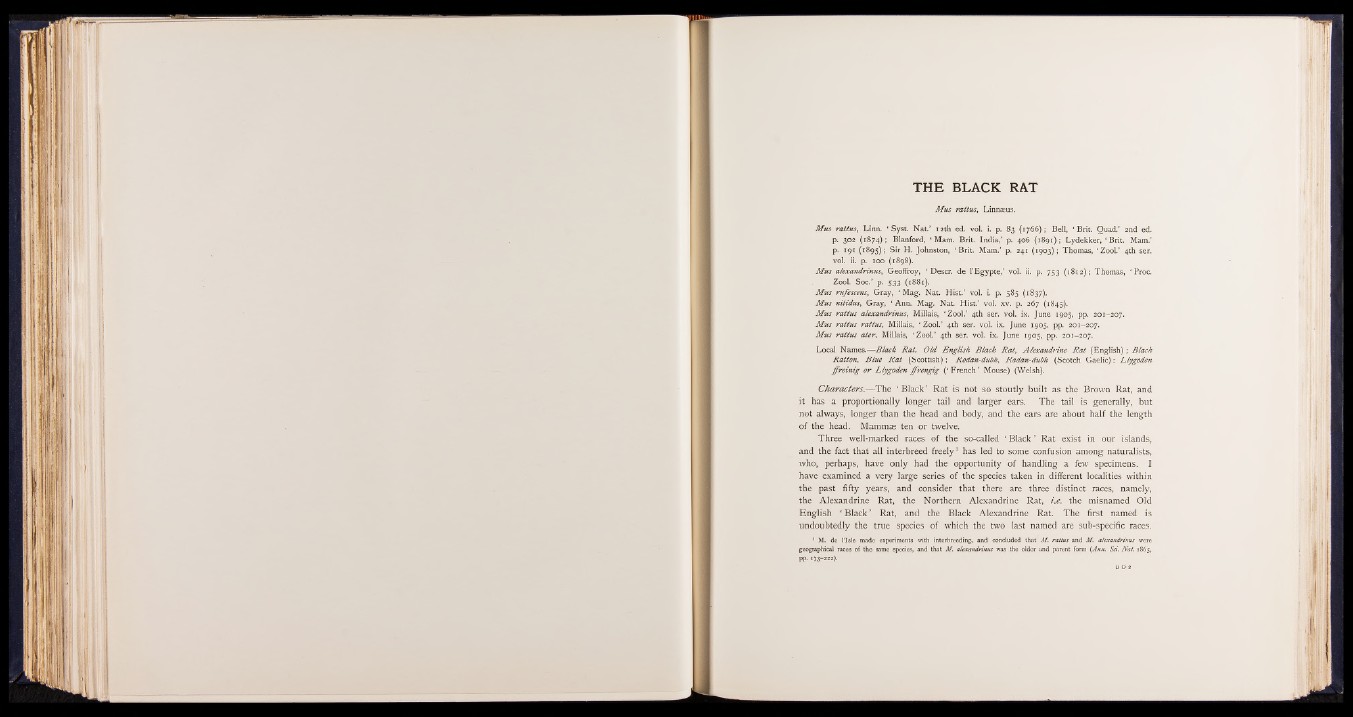
THE BLACK RAT
Mus rattus, Linnseus.
Mus rattus, Linn. ‘ Syst. Nat.’ 12th ed. vol. i. p. 83 (1766); Bell, ‘ Brit. Quad.’ 2nd ed.
p. 302 (1874); Blanford, ‘ Mam. Brit. India,’ p. 406 (1891); Lydekker, ' Brit. Mam.’
p. 191 (1895); Sir H. Johnston, ‘ Brit. Mam.’ p. 241 (1903); Thomas, ‘ Zool.’ 4th ser.
vol. ii. p. 100 (1898).
Mus alexandrinus, Geoffroy, 4 Descr. de l’Egypte,’ vol. ii. p. 753 (1812); Thomas, ‘ Proc.
Zool. Soc.’ p. 533 (1881).
Mus rufescens, Gray, ‘ Mag. Nat. Hist.’ vol. i. p. 585 (1837).
Mus nitidus, Gray, ‘ Ann. Mag. Nat. Hist.’ vol. xv. p. 267 (1845).
Mus rattus alexandrinus, Millais, ‘ Zool.’ 4th ser. vol. ix. June 1905, pp. 201-207.
Mus rattics rattus, Millais, ‘ Zool.’ 4th ser. vol. ix. June 1905, pp. 201—207.
Mus rattus ater, Millais, ‘ Zool.’ 4th ser. vol. ix. June 1905, pp. 201-207.
Local Names.—Black Rat, Old English Black Rat, Alexandrine Rat (English); Black
Ration, Blue R at (Scottish); Rodan-dubh, Radan-dubh (Scotch Gaelic): Llygoden
ffreinig or Llygoden ffrengig (‘ French’ Mouse) (Welsh).
Characters.—The ‘ Black ’ Rat is not so stoutly built as the Brown Rat, and
it has a proportionally longer tail and larger ears. The tail is generally, but
not always, longer than the head and body, and the ears are about half the length
of the head. Mammae ten or twelve.
Three well-marked races of the so-called ‘ Black ’ Rat exist in our islands,
and the fact that all interbreed freely1 has led to some confusion among naturalists,
who, perhaps, have only had the opportunity of handling a few specimens. I
have examined a very large series of the species taken in different localities within
the past fifty years, and consider that there are three distinct races, namely,
the Alexandrine Rat, the Northern Alexandrine Rat, i.e. the misnamed Old
English ‘ Black ’ Rat, and the Black Alexandrine Rat. The first named is
undoubtedly the true species of which the two last named are sub-specific races.
1 M. de l’Isle made experiments with interbreeding, and concluded that' M. rattus and M. alexandrinus were
geographical races of the same species, and that M. alexandrinus was the older and parent form (Ann. Sei. Nat. 1865,
pp. 173-222).